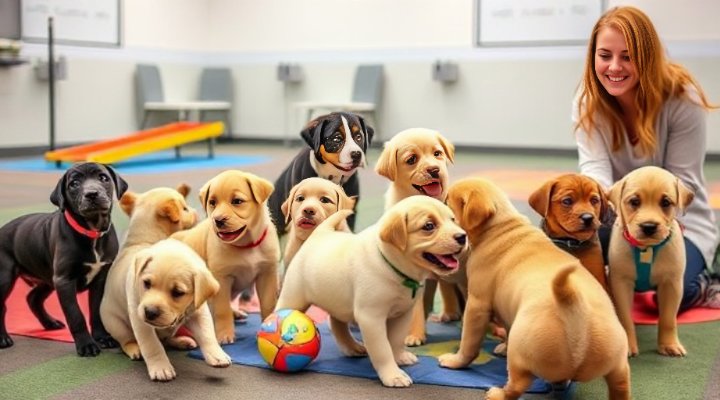Enrolling your puppy in obedience classes is one of the best decisions you can make for their long-term behavior and well-being. Puppy obedience class essentials include socialization, basic commands, and positive reinforcement techniques. These classes not only help your puppy become a well-behaved companion but also strengthen the bond between you and your pet. In this article, we’ll explore the key components and benefits of puppy obedience classes, providing you with all the information you need to get started.

Why Puppy Obedience Classes Are Essential
Puppy obedience classes are designed to teach your furry friend the basics of good behavior. From learning to sit and stay to walking nicely on a leash, these classes cover all the fundamentals. Moreover, they provide a structured environment where your puppy can learn to focus and follow instructions, even with distractions around.
For example, my own Labrador, Max, was a handful until we enrolled him in a local puppy obedience class. Within weeks, he was responding to commands and behaving much better at home. The transformation was incredible!

Key Components of Puppy Obedience Classes
Socialization
One of the most important aspects of puppy obedience classes is socialization. Puppies need to learn how to interact with other dogs and people in a positive way. This helps prevent behavioral issues like aggression or fearfulness later in life.
During these classes, your puppy will meet other dogs of similar age and size, which is crucial for their development. Socialization also includes exposure to different environments, sounds, and experiences, making your puppy more adaptable and confident.

Basic Commands
Teaching your puppy basic commands like sit, stay, come, and heel is another essential component of obedience classes. These commands form the foundation for more advanced training and ensure your puppy is well-behaved in various situations.
For instance, a well-trained puppy who knows to ‘come’ when called is much safer in potentially dangerous situations. Similarly, a puppy that can ‘sit’ and ‘stay’ is easier to manage in public places.
Positive Reinforcement
Positive reinforcement is the cornerstone of effective puppy training. This method involves rewarding your puppy for good behavior with treats, praise, or playtime. It encourages them to repeat the desired behavior and makes learning fun and engaging.
In my experience, using positive reinforcement with Max not only sped up his learning but also made our training sessions enjoyable for both of us. He was always eager to participate, knowing there would be rewards involved.

Benefits of Enrolling Your Puppy in Obedience Classes
There are numerous benefits to enrolling your puppy in obedience classes. Firstly, it helps establish good behavior early on, preventing bad habits from forming. Secondly, it strengthens the bond between you and your puppy, as you work together towards common goals.
Additionally, obedience classes provide mental stimulation for your puppy, which is just as important as physical exercise. A mentally stimulated puppy is less likely to engage in destructive behaviors out of boredom.
Lastly, these classes offer professional guidance, ensuring you’re using the most effective training techniques. If you’re looking for more advanced training options, you might consider dog agility training or therapy dog training as your puppy grows.
Conclusion
Puppy obedience class essentials are vital for raising a well-behaved and happy pet. From socialization to basic commands and positive reinforcement, these classes provide everything your puppy needs to thrive. By enrolling your puppy in obedience classes, you’re setting them up for a lifetime of good behavior and strengthening your bond in the process.
If you’re ready to start, check out our guide on puppy obedience training near me to find the perfect class for your furry friend.
